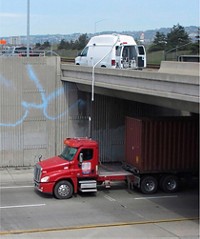Advertisement
Grab your lab coat. Let's get started
Welcome!
Welcome!
Create an account below to get 6 C&EN articles per month, receive newsletters and more - all free.
It seems this is your first time logging in online. Please enter the following information to continue.
As an ACS member you automatically get access to this site. All we need is few more details to create your reading experience.
Not you? Sign in with a different account.
Not you? Sign in with a different account.
ERROR 1
ERROR 1
ERROR 2
ERROR 2
ERROR 2
ERROR 2
ERROR 2
Password and Confirm password must match.
If you have an ACS member number, please enter it here so we can link this account to your membership. (optional)
ERROR 2
ACS values your privacy. By submitting your information, you are gaining access to C&EN and subscribing to our weekly newsletter. We use the information you provide to make your reading experience better, and we will never sell your data to third party members.
Pollution
California truck regulations are tackling NOx
The state’s heavy duty diesel trucks are producing less of the pollutants responsible for acid rain and smog, according to new data
by Katherine Bourzac
December 19, 2018

Heavy-duty diesel trucks have been a major source of particulate pollution and of nitrogen dioxide and nitric oxide, collectively called NOx. NOx contributes to acid rain and reacts with volatile organic matter in the atmosphere to form smog. Systems added to trucks to clean up their NOx emissions have led to marked improvements in pollution control at ports and on highways in California, according to research presented Dec. 12 at the American Geophysical Union fall meeting in Washington, DC. However, not all emissions decreased: Levels of other nitrogen species such as ammonia, which has negative impacts on water quality, increased.
NOx emissions from heavy-duty trucks have been the target of regulations at both the federal and state levels. Nationwide, trucks built after 2010 must include selective catalytic reduction systems to catch NOx before they are emitted and reduce them to inert nitrogen gas. In most states, operators are not required to retrofit or retire older engines, which can last for up to 25 years. California has been more aggressive about taking older trucks off the road: By 2023, all heavy-duty diesel trucks in the state must have NOx-scrubbing systems.
“California provides a preview of what’s coming nationally,” says Robert Harley, an environmental engineer at the University of California, Berkeley.
To see how the state’s regulations are playing out, Harley’s group used a roving lab-in-a-van to capture and analyze truck emissions at two spots in the San Francisco Bay area from 2011 to this year. The van is outfitted with spectrometers and other analytic tools fed by a flexible air duct. The researchers park the van on an overpass, dangle the duct over the side, and then collect puffs of air. Heavy-duty trucks typically have a vertical exhaust pipe that lines up with the sampling duct. As a truck drives underneath, the system samples the air once every second. Cameras snap a photo of the truck’s license plate for comparison with a database, allowing the researchers to determine the vehicle’s model, year, and engine type, as well as what kind of emissions-scrubbing systems are on board.
Using this van, Harley and fellow UC Berkeley engineer Thomas Kirschstetter measured nitrogen-containing gases emitted by passing heavy-duty diesel trucks at the Port of Oakland in 2011, 2013, and 2015, and at Oakland’s Caldecott Tunnel in 2014, 2015, and 2018. Trucks with engines from 2010 or later emitted 76 to 86% less NOx than older ones not fitted with selective catalytic reduction systems. However, trucks carrying these systems emitted ammonia, which is not regulated but can cause water quality problems, and nitrous oxide. None of the trucks exceeded the state’s limits on the latter.
It’s not clear why these other pollutants are present. Selective catalytic reduction systems work by pumping a stream of urea into hot exhaust. In the heat, the urea degrades into ammonia, which then reduces NOx. Chelsea Preble, a chemistry postdoc at UC Berkeley who was part of the research team, says the selective catalytic reduction systems may be producing more ammonia than is needed to reduce NOx, with the excess getting emitted in the truck’s exhaust, Another possibility, she says, is that catalysts in the systems may not be efficient, leading to incomplete reduction of NOx. The nitrous oxide-production mechanism is more complex, she says, and may result from the interplay between the NOx scrubber and other systems designed to capture particulate matter. These filters can produce an excess of nitrogen dioxide, which can decompose to form nitrous oxide.
Advertisement
These off-target emissions are subtle but may be consequential. And they demonstrate that there’s still room for improvement in designing pollution-scrubbing systems, says Gary Bishop, a research engineer at the University of Denver. Bishop has studied emissions from heavy and medium duty trucks in southern California. His work, published in April (Environ. Sci. Technol. 2018, DOI: 10.1021/acs.est.8b00621), suggests that when a truck’s engine is cold, the selective catalytic reduction system does not work at all. When driving long distances, the engine gets hot enough to scrub out NOx. At ports, cargo trucks are stopped for long periods of time and travel only short distances. And in cities and suburbs, garbage trucks stop frequently, and their engines stay relatively cold. In these cases, NOx scrubbers may simply not work. In Bishop’s study at the Port of Los Angeles, some trucks fitted with catalytic reduction systems had similar NOx emissions to trucks that lack them entirely.
Bishop says these kinds of bumps in the road are to be expected. It will take time for the scrubbing technology to mature, as it did for the catalytic converters found on passenger vehicles. He suspects manufacturers will keep improving the systems to forestall more aggressive regulation. “NOx is a success story, it’s just not complete yet,” Bishop says.





Join the conversation
Contact the reporter
Submit a Letter to the Editor for publication
Engage with us on Twitter